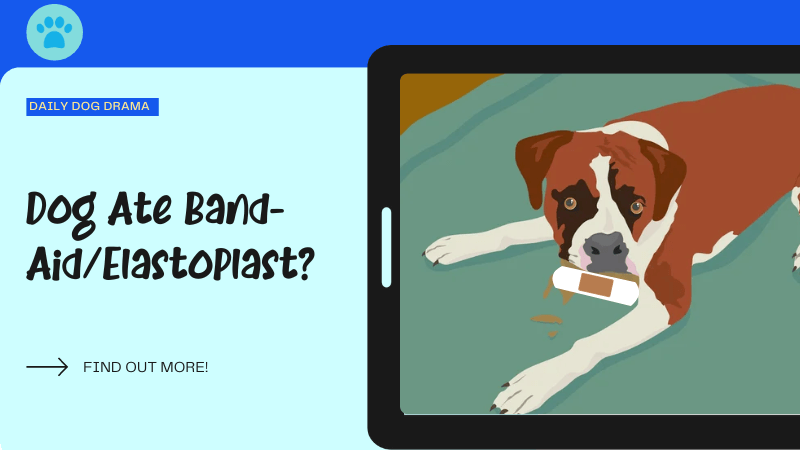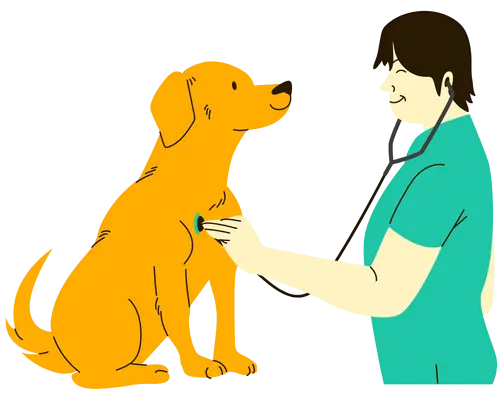Do you know what DOG ESSENTIALS you are missing out? Find out now!
Zack Keithy, our author, is a certified veterinarian technician (UC Blue Ash) for over 6 years (contact him here). The articles written here are based on his expertise and experience, combined with a review by our expert vet reviewers including Dr M. Tarantino. Learn more about us here.
As a dog owner, it can be terrifying to think about what might happen if your furry friend ingests something they shouldn’t.
What if your dog ate band aid?
In the majority of cases, your dog will be ok after eating a bandaid. Most bandaids are not toxic to dogs and will not cause any poisoning. The biggest risk is that it becomes a choking hazard, which can happen if it ingested more than a few strips.
I know that you may be feeling anxious and unsure of what to do next, but don’t worry – we’re here to help.
In this blog post, we’ll provide the information and guidance you need to take care of your dog and help them recover.
Keep reading to learn more!
Medical Questions? Talk to a Veterinarian 24/7.
Connect one-on-one with a licensed vet who will answer your questions in minutes.
*Article may contain affiliate links to retailers like Amazon and Chewy. Learn more on our disclosure page.

- What to Do if Your Dog Ate a Band Aid?
- What Will Happen to a Dog That Eats a Band-aid?
- What Problems Can Happen if Your Dog Ate a Piece of Bandaid?
- How Long Does It Take for a Dog to Pass a Band-aid?
- Can Dogs Poop Out Band-aids?
- Do Band-aids Dissolve in a Dog's Stomach?
- Can a Dog Still Poop With a Blockage?
- What to Give a Dog to Help Them Pass an Object?
- How Can You Prevent Your Dog From Eating a Bandaid Again?
- How Much Does It Cost to Remove an Object From a Dog's Stomach?
- Can a Dog Die From Eating a Band-aid?
- Frequently Asked Questions (FAQs)
- In Conclusion: Dog Ate Band Aid/Elastoplast?
What to Do if Your Dog Ate a Band Aid?
I always tell dog owners to be watchful of their dogs.
One minute it is lying there and the next, it looks like it is chewing on something.
The moment you see your dog doing that, you need to step right up and open its mouth to see what’s going on.
Obviously, if the item is still in its mouth, you can attempt to remove it yourself.
However, if the object has gone partway or full way down its throat, DO NOT try to use a tweezer or something similar to take it out.
You might just hurt your dog instead.
Also, you might want to learn a bit about the Heimlich maneuver so that you are ready if your dog ever chokes.
Just keep a careful eye on your dog over the following 24 to 48 hours for any signs of choking or other digestive issues.
If your dog has consumed several bandages, is experiencing pain or discomfort, or if there has been a change in their behavior, you should call your veterinarian immediately.
Hey there, sorry to interrupt but I wanted to tell you about an online vet service I’ve been using for years.
An in-person visit with one is great, but it’s not always an option.
Now, thanks to technology, you can speak to one without leaving your home.

Got something to ask a vet?
Talk to one anytime, 24/7.
* Don’t use this service for emergencies.
Alternatively, a vet can come out to you instead (exclusive to our readers: use THEVETS15 for 15% off).
SCHEDULE AN APPOINTMENT HEREThank you. The rest of the article continues below.
What about if your dog ate makeup wipes?
What Will Happen to a Dog That Eats a Band-aid?
If a dog just consumes one adhesive bandage of the average size—the kind that is often included in first-aid kits for use in the home—there is a good chance that the dog will not experience any severe side effects.
Ingestion of a particularly big bandage, many bandages, or additional medical gauze along with the bandage might cause digestive issues in a dog.
When a dog eats a bandage, they run the risk of developing issues such as vomiting, diarrhea, choking (which occurs more often in smaller dogs), or a digestive obstruction.
The size of the bandage, the quantity of the dog that consumes it, and whether or not the bandage included any pharmaceuticals or ointments all play a significant role in determining how a dog would react after chewing a band-aid.
The likelihood of experiencing and seeing negative consequences is increased when the dog in question is a puppy.
Doggy says, read this too: How to Remove Sticky Bandage From My Dog? [Home Remedy]
What Problems Can Happen if Your Dog Ate a Piece of Bandaid?
In most cases, your dog eating a band-aid will not cause a lot of harm.
However, some of the problems that can happen include:
Digestive upset
A dog may have digestive issues if it consumes many bandages after getting into a container of bandages and eating them.
Blockage
Sometimes the bandages may become clumped together and form a ball, which can cause a blockage in the dog’s digestive tract.
This can lead to more significant issues with the dog’s ability to process food and waste.
Choking
Dogs may likely choke if they try to swallow a band-aid since they are not designed to do so securely.
This condition is most prevalent in puppies and younger dogs.
The risk of choking increases for any dog when using larger bandages intended for more severe injuries or when bandages are eaten in addition to medical gauze.
Vomiting/Diarrhea
When applied to human wounds, bandages are often used in conjunction with various types of medicinal ointments.
Even if these ointments are helpful for the wound, consuming them might have adverse effects on the dog.
Most medicinal ointments are not hazardous in small doses; nonetheless, they may cause stomach irritation in a dog, which may result in the dog throwing up or having diarrhea.
Doggy says, consider reading this too: My dog ate a cricket
How Long Does It Take for a Dog to Pass a Band-aid?
It should take anywhere from one to two days for a band-aid to make its way through the digestive system of a dog.
You will likely be able to see the band-aid in your dog’s waste since it does not decompose.
If a bandage causes stomach irritation for your dog, he or she may vomit; in this case, you should inspect the dog’s feces for the missing bandage.
What should you do if your dog ate glitter?
Can Dogs Poop Out Band-aids?
In most cases, a bandage that is eaten by a dog will pass through its digestive tract and be excreted in its feces.
Small dogs, on the other hand, have a greater likelihood of being unable to do so.
As a result of the adhesive that is on the bandages, they can clump together in the stomach of a dog, which may make it difficult for the bandages to move through the dog’s digestive system.
Hungry for more knowledge? Read this too: My Dog Sounds Like He Has a Hairball: What Do I Do?
Do Band-aids Dissolve in a Dog’s Stomach?
Band-aids will not break down in the digestive tract of a dog, but instead will be in the waste produced by your dog.
If the band-aid causes stomach upset for your dog, the band-aid may wind up being vomited up, where it will be visible.
Can a Dog Still Poop With a Blockage?
A dog can develop diarrhea if it has a partial blockage because the liquid will try to squeeze past the impediment.
If there is a total obstruction, the dog may make an effort to poop but will be unable to do so.
Doggy says, you might be keen to read this too: Accidentally hurt my dog. What to do next?
What to Give a Dog to Help Them Pass an Object?
In general, it takes about an hour or so for a dog to poop after eating.
When it ingests a foreign object though, this might take longer for it to appear.
Something you can try is to feed your dog a substantial meal of dry food.
Food stimulates the production of digestive fluids, which may make it easier to pass through the digestive tract. Offering plenty of fresh water should help too.
Other than that, there is really nothing much you can do except wait for nature to take its course.
Hey there, sorry to interrupt but I wanted to tell you about an online vet service I’ve been using for years.
An in-person visit with one is great, but it’s not always an option.
Now, thanks to technology, you can speak to one without leaving your home.

Got something to ask a vet?
Talk to one anytime, 24/7.
* Don’t use this service for emergencies.
Alternatively, a vet can come out to you instead (exclusive to our readers: use THEVETS15 for 15% off).
SCHEDULE AN APPOINTMENT HEREThank you. The rest of the article continues below.
How Can You Prevent Your Dog From Eating a Bandaid Again?
Here are some tips to help prevent your dog from eating a band-aid again in the future:
- Keep your first aid kit out of reach. Make sure that your first aid kit is stored in a place that is inaccessible to your dog. This could be a high cabinet, a locked drawer, or a closet with a child-proof latch.
- Dispose of used band-aids properly. After using a band aid, make sure to dispose of it immediately. Don’t leave used band aids lying around where your dog can find them – instead, toss them in the trash or a covered garbage can.
- Keep your trash cans secure. If your trash cans have lids that can be easily opened by your dog, consider getting locking lids or storing your trash cans in a closet or other secure area.
- Use a bitter apple spray. Bitter apple spray is a taste deterrent that can help prevent your dog from chewing on objects it shouldn’t. You can apply the spray to your first aid kit, trash cans, and other objects that your dog may be tempted to chew on.
- Supervise your dog. As always, it’s important to supervise your dog when they’re in the house. This will help you catch any potential problems before they happen. If you notice your dog trying to chew on something they shouldn’t, redirect their attention to a chew toy or another appropriate object.
It’s always important to be prepared in case of emergencies – so make sure to keep your veterinarian’s phone number handy, and know what to do if your dog does swallow an object they shouldn’t.
How Much Does It Cost to Remove an Object From a Dog’s Stomach?
The cost to remove a foreign item from a dog may range anywhere from $1,500 up to over $10,000 if surgery is required.
Even in cases when surgery is not required, the removal of a foreign item may nevertheless result in costs ranging from $300 to $1,200 for the owners.
Can a Dog Die From Eating a Band-aid?
In most cases, a dog will not die from eating a band-aid.
Band-aids are typically made of soft, pliable materials that are unlikely to cause an obstruction in your dog’s intestines.
However, if your dog eats a large number of them, or if they were stuck together, they may cause an intestinal blockage.
This can be very dangerous and may require immediate medical attention.
Frequently Asked Questions (FAQs)
Is there anything toxic to dogs in band-aids?
Most band aids do not contain anything toxic to your dog, but you should be aware of the type that you have around your home. Some are treated with antibiotics to help prevent infection. If your dog eats them, it could potentially overdose. This could cause side effects such as vomiting, diarrhea, or more serious health problems.
Can my dog get sick if it eats a used bandaid?
While most band-aids are not toxic to dogs, they may contain small amounts of bacteria or other contaminants that could cause illness. Additionally, if your dog eats a used band-aid that has been in contact with your skin, they could potentially ingest any medications or other substances that were on your skin at the time. This could cause side effects or allergic reactions in your dog.
In Conclusion: Dog Ate Band Aid/Elastoplast?
If your dog has eaten a band-aid, there’s no need to panic.
While it’s important to take action and monitor your dog for any potential problems, most band-aids are not toxic to dogs and will pass through their digestive system without causing any issues.
A quick call to your vet can also allay some of your fears, but most importantly, keep a calm and cool head and not stress out your dog!
Check out other dog care articles on our blog such as Cavalier King Charles Spaniel yelps when picked up, does pine sol kill fleas, should you put a puppy pad in a crate at night, and many more!
You’ve made it to the end, but I hope it’s not the end of our journey. We want to hear your voice! Share your thoughts, problems, suggestions, or anything related to your dog in the comments section. And don’t forget to join our newsletter today too.



